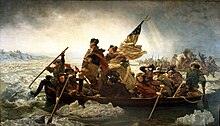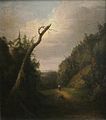Worthington Whittredge
Thomas Worthington Whittredge (born May 22, 1820 in Springfield , Ohio , † February 25, 1910 in Summit , New Jersey ) was an American landscape painter and President of the National Academy of Design . He is considered a representative of the Düsseldorf School of Painting and the Hudson River School .
Life
Whittredge was born in a log cabin and grew up on his father's farm near the Little Miami River . In 1837, at the age of 17, he went to Cincinnati , where he worked as a decoration and sign painter with his brother-in-law Alwin Baldwin. He tried his hand at landscape painting at an early age. He exhibited his first three landscapes in 1839 at the Cincinnati Academy of Fine Arts. An attempt Daguerrotypist to be failed. In 1840 he moved to Indianapolis . There he worked as a portrait painter . Among other things, he portrayed Harriet Beecher Stowe , with whose family he lived. He gave up portrait painting in 1843 while living in Charleston, West Virginia . Then he moved back to Cincinnati, where he worked as a landscape painter. His early American work shows a relationship to landscapes by Thomas Cole and Thomas Doughty , both representatives of the Hudson River School, whose art he may have been introduced to through his friend Benjamin McConkey (~ 1821–1852). The now lost painting View on the Kanawha River, Morning , for which he received a letter of appreciation from Asher Brown Durand , he exhibited in 1846 at the National Academy of Design in New York City .

In the spring of 1849 he traveled from there to London . He spent the first summer in Europe on study trips to Belgium and Germany. Via Paris , where he met McConkey again, he came to Düsseldorf . Here he first met his compatriot Emanuel Leutze . This helped him to find his way around the city, in which he had appeared from September 1849 both as a student and as a negotiator for American art collectors. Soon he was working alongside Eastman Johnson and other painters in Leutzes studio and was his model for the painting Washington Crossing the Delaware both as George Washington and as a helmsman .
Before he got an apartment and his own studio in Leutze's house, Whittredge rented an attic room in the house of the Düsseldorf landscape painter Andreas Achenbach for about a year in 1849/1850 . He was also allowed to work in his studio. From this and from Whittredge's memoirs, the conclusion was long drawn that he had studied with Achenbach. However, the role of Achenbach, who rejected closer teacher-student relationships , for the artistic development of his tenant was primarily that of a role model, advisor and critic.
He stayed in Düsseldorf until 1856 and - also as a negotiator for Joseph Longworth (1813–1883) and other art collectors in Cincinnati - had contact with other artists such as Carl Friedrich Lessing , Hans Fredrik Gude and Albert Bierstadt . In 1853 he received a visit from his painter friend John Robinson Tait from Cincinnati. From 1850 to 1856 he was a member of the artists' association Malkasten , the sociable center of the colony of American painters in Düsseldorf. Like Leutze, he joined the Association of Düsseldorf Artists in 1854 .
During this time he traveled to almost all European art centers in order to educate himself in museums and galleries by looking at important works and by making copies and sketches. He also made trips to picturesque landscapes, such as Westphalia, with his friends Bierstadt, William Henry Furness , Sanford Robinson Gifford , William Stanley Haseltine , John Beaufain Irving , Henry Lewis , Enoch Wood Perry and William Dickinson Washington on the Middle Rhine and the Nahe , where they were enthusiastic about the romanticism of castles and the Rhine , or study trips to the Harz with Lessing and Gude . Impressed by the Rhine landscape, he used set pieces in his works, which he successfully sold in America.
In the summer of 1856 he traveled up the Rhine via Switzerland to Rome on a group tour he organized for American painters , where he worked for four years before returning to the United States. There was also a colony of American painters in Rome, where he frequented. From Rome he roamed the surrounding landscapes, for example, he hiked around Lake Nemi with Gifford, Haseltine, William Beard and Thomas Buchanan Read . From December 1856 to 1857 Whittredge was a member of the German Artists' Association in Rome.

In 1859 he returned to the United States. He settled in New York City as a landscape painter and moved into a studio in Manhattan in the Tenth Street Studio Building, where some of his friends also worked. From there he traveled to areas in New England and New York State . In 1865/1866 Whittredge accompanied US General John Pope on a trip to Colorado and New Mexico , across the Great Plains along the Rocky Mountains . In 1870 he made a similar tour there with friends Gifford and John Frederick Kensett . Between 1860 and 1886 he made several trips to the Catskill and the Shawangunk Mountains , some with Jervis McEntee (1828-1829).

In 1880 he moved from New York City to Summit, New Jersey with his wife, Euphemia, née Foot, whom he married in 1867, and their four daughters. There he lived until the end of his life in an impressive Victorian house called "Hillcrest". He remained active as a painter until 1904. A preferred venue for his pictures was the New York club, The Century Association , to which he had been a member since 1862 and where a total of 125 of his paintings were presented in a large exhibition in March 1904.
As one of the leading landscape painters in the United States, Whittredge combined influences of his time in Düsseldorf (especially influences from Lessing, Bierstadt, Andreas Achenbach and Johann Wilhelm Schirmer ) with those of the Hudson River School and the painting of Barbizon . Under French influence, he made quick, fleeting oil sketches in the 1850s, but only a few have survived. He was praised for his accurate drawing, his composition and the sensitivity of his coloring.
Most of the works created in Düsseldorf were commissioned works for collectors in Cincinnati who especially ordered Swiss motifs and Italian landscapes. Occasionally he even received commissions for American landscape themes in Düsseldorf. He produced common motifs in series. Some landscapes, which he sent to exhibitions of the Western Art Union in Cincinnati or the American Art Union in New York City, he first exhibited in the permanent art exhibition of the Kunstverein für die Rheinlande und Westfalen . Since the client's artistic taste often led to specifications that Whittredge himself did not master very well, he may have increasingly moved on to buying or copying works from colleagues in Düsseldorf. Although he had initially adopted their compositional principles and often subdued colors ("Atelierton"), he later distanced himself from the style of the Düsseldorf School in critical statements.
In 1861, Thomas Worthington Whittredge was elected a member of the National Academy of Design in New York. From 1874 to 1875 he served her as president. In 1876 he was a member of the selection committee of the Centennial Exhibition in Philadelphia , in 1878 he held the same position for the Paris World Exhibition .
Whittredge said of his artistic career: “Art is universal. It knows no countries and no borders. "
gallery
Scene near Hawk's Nest , 1845
Summer Pastorale (View of Kallenfels ) , 1853
View Near Fountain on Lake Lucerne , 1857
The Amphitheater of Tusculum and Albano Mountains , 1860
Indians Crossing the Platte River , 1867
On the Cache la Poudre River , 1871
literature
- Worthington Whittredge . In: Elizabeth Mankin Kornhauser, Amy Ellis, Maureen Miesmer: Hudson River School. Masterworks from the Wadsworth Atheneum Museum of Art . Yale University Press, New Haven and London 2003, ISBN 978-0-300-10116-4 , p. 148 ( Google Books ).
- John Wilson: Cincinnati Artists and the Lure of Germany in the Nineteenth Century . In: Queen City Heritage , Volume 57, No. 4 (Winter 1999), p. 5 f. ( PDF ).
- Worthington Whittredge . In: Metropolitan Museum of Art (ed.): American Paradise. The World of the Hudson River School . New York City / New York 1987, ISBN 0-87099-496-4 , pp. 179 f. ( Google Books ).
- Cheryl A. Cibulka: Quiet Places. The American Landscapes of Worthington Whittredge . Exhibition catalog, Adams Davidson Galleries, Washington, DC 1982.
- Anthony F. Janson: The Paintings of Worthington Whittredge . Dissertation, Harvard University, Cambridge / Massachusetts 1975.
- Edwin H. Dwight: Worthington Whittredge (1820-1910). A Retrospective Exhibition of an American Artist . Exhibition catalog, Munson-Williams-Proctor Institute, Utica / New York 1969.
- John IH Baur (Ed.): The Autobiography of Worthington Whittredge, 1820-1910 . In: Theodore D. Starr Jr. (Ed.): Brooklyn Museum Journal , 1942, Brooklyn Institute of Arts and Sciences, Brooklyn Museum Press, Brooklyn / NY 1942 ( digitized ).
Web links
- Worthington Whittredge , data sheet in the rkd.nl portal( Rijksbureau voor Kunsthistorische Documentatie )
- Thomas Worthington Whittredge. Summit Resident And a Legacy in the Hudson River School of Painting , website in the portal summithistoricalsociety.org
- Thomas Worthington Whittredge , website in the mona.unk.edu portal
Individual evidence
- ^ Sabine Morgen: The broadcast of the Düsseldorf painting school to America in the 19th century. Düsseldorf paintings in America and American painters in Düsseldorf . Göttingen Contributions to Art History, Volume 2, Göttingen 2008, ISBN 978-3-7675-3059-1 , p. 589
- ↑ Bettina Baumgärtel , Sabine Schroyen, Lydia Immerheiser, Sabine Teichgröb: Directory of foreign artists. Nationality, residence and studies in Düsseldorf . In: Bettina Baumgärtel (Hrsg.): The Düsseldorf School of Painting and its international impact 1819–1918 . Michael Imhof Verlag, Petersberg 2011, ISBN 978-3-86568-702-9 , Volume 1, p. 442
- ^ Friedrich Noack : The Germanness in Rome since the end of the Middle Ages . Deutsche Verlags-Anstalt, Stuttgart 1927, Volume 2, p. 641
- ↑ Sabine Morgen, p. 592 f.
| personal data | |
|---|---|
| SURNAME | Whittredge, Worthington |
| ALTERNATIVE NAMES | Whittredge, Thomas Worthington |
| BRIEF DESCRIPTION | American painter |
| DATE OF BIRTH | May 22, 1820 |
| PLACE OF BIRTH | Springfield , Ohio, USA |
| DATE OF DEATH | February 25, 1910 |
| Place of death | Summit , New Jersey , USA |










